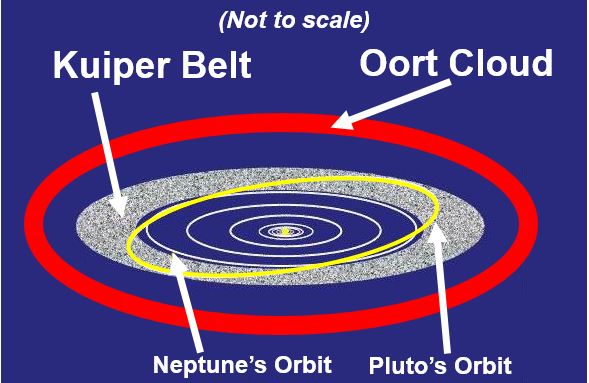Scientists have detected our Solar System’s most distant object even seen, a frigid world very far away – 103 times further from the Sun than we are. This breaks the previous record held by the dwarf planet Eris, discovered in 2005, which is 97 times further from the Sun than Earth is.
The object was reported on 10th November by Scott Sheppard, an astronomer at the Carnegie Institution for Science in Washington DC. He reported his finding at the American Astronomical Society’s Division for Planetary Sciences meeting in National Harbor, Maryland.
The distant object lies beyond the edge of the Kuiper belt, a region in our Solar System beyond the planets, extending from Neptune’s orbit (at 30 AU) to about 50 AU from the Sun. (1 AU = 1 Earth-to-Sun distance).
 If the distant objects orbit remains within the Oort Cloud all the time, scientists will be intrigued.
If the distant objects orbit remains within the Oort Cloud all the time, scientists will be intrigued.
It is within the Oort cloud, the next part of the solar system which stretches to a distance of 100,000 AU.
Object hopefully undisturbed for billions of years
Its very distant position suggests it could be of scientific importance to researchers on Earth. Objects in this primordial realm follow orbits that have remained undisturbed for several billion years.
Astronomers do not yet know enough about this object to determine what its full orbit path is. It might move much closer to the Sun than its current 103 AU. If it doesn’t, it would significantly raise the interest of astronomers.
Nature News quoted Michael Brown, a planetary scientist at the California Institute of Technology in Pasadena, who said “There’s no reason to be excited yet.”
This discovery gives us a rare glimpse into the outer fringes of our Solar System. We know of just two worlds in the inner Oort cloud: an object called 2012 VP (nicknamed ‘Biden’), identified by Sheppard and Chadwick Trujillo, of the Gemini Observatory in Hilo, Hawaii, and Sedna, discovered by Brown and his collaborators.
2012 VP never comes closer than 80 AU to the Sun, while Sedna’s closest approach is 76. If this new objects closest distance to the Sun is 103 AU, the group of two scientifically fascinating residents of the inner Oort cloud will increase to a group of three.
If, however, it moves much closer to our Sun – entering the Kuiper Belt at around 50 AU – it will be seen as several other, more mundane Kuiper belt residents whose orbits are particularly elliptical because of Neptune’s gravitational force.
Far-away objects fascinate scientists
Sheppard explains that objects in the inner Oort are much more intriguing for scientists than those within the Kuiper Belt because they are too distant to have ever been influenced by Neptune’s gravitational pull. Their orbits likely reflect the primordial (original) conditions of the Solar System, which was formed over 4.5 billion years ago – making them much more tantalizing for astronomers.
Trujillo and Sheppard discovered the object using the Subaru Telescope, an 8.2 meter flagship telescope of the National Astronomical Observatory of Japan, located at the Mauna Kea Observatory in Hawaii.
They say the body is probably between 500 to 800 kilometers across. Next week, they plan to seek it out again using the Magellan Telescopes, two 6.5 meter (diameter) optical telescopes located at the Las Campana Observatory in Chile.
Within the next year, they hope to calculate its orbit and learn whether it is a permanent Oort cloud resident.
Citation: “Astronomers spy most distant Solar System object ever,” Alexandra Witze. Nature. 10 November 2015. DOI: 10.1038/nature.2015.18770.

